Papers by Anthony Szymczyk
HAL (Le Centre pour la Communication Scientifique Directe), Sep 7, 2009
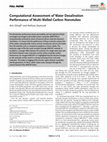
Advanced theory and simulations, Feb 24, 2020
The desalination performance (water permeability and salt rejection) of both uncharged and charge... more The desalination performance (water permeability and salt rejection) of both uncharged and charged multi-walled carbon nanotubes (MWCNTs) is computationally assessed by means of pressure-driven molecular dynamics simulations. It is shown that the performance of these materials surpass that of the widely used polyamide reverse osmosis membranes and are even better than 2D materials such as nanoporous graphene or boron nitride. The molecular origin of the fast water transport through MWCNT materials is ascribed to a synergic effect between the existence of a single water layer and low friction between water molecules and the carbon nanotube surface. Furthermore, for charged MWCNTs it is highlighted that the electrical charges on the nanotube surface result in a strong anchoring of ions and water molecules. This leads to clogging of the annular region between nanotubes and the generation of a force, which makes water transport through the central channel of the MWCNT faster.

Renewable Energy, Dec 1, 2021
Abstract The present work examines, for the first time, the use of thiolated graphene oxide (TGO)... more Abstract The present work examines, for the first time, the use of thiolated graphene oxide (TGO), in polyelectrolyte composite membranes as an effective approach to enhance the MFC performance. A new composite membrane based on a sulfonated polyethersulfone (SPES) hybrid with GO, sulfonated GO (SGO), and TGO was fabricated and assessed in MFC. The blend membranes were characterized with various techniques. The sulfhydryl (-SH) and sulfonic (-SO3H) groups enhanced the proton selectivity of the membrane and MFC performance. The MFC using the SPES/SGO1.8% composite membrane generated a power density of 66.4 mW/m2 which was double that produced by MFC using Nafion117 membrane in batch mode which lasted for 8 days. The SPES/SGO membrane was more selective towards H+ rather than other cations (K+, Na+, and Li+). This was also confirmed by the results of proton conductivity analysis, as the SPES/SGO1.8% membranes showed a value of 1.42 mS/cm which was higher than Nafion117 (1.3 mS/cm), SPES/TGO1.8% (1.25 mS/cm), SPES/GO1.8% (0.56 mS/cm), and SPES (0.32 mS/cm). The higher COD removal and coulombic efficiency were obtained in MFC with SPES/SGO membranes. In conclusion, it is our view that the new SPES/SGO and SPES/TGO membranes can be applied favorably in dual-chamber MFCs meeting their needs.
Coordination Chemistry Reviews, Oct 1, 2023
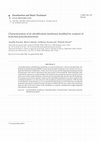
Desalination and Water Treatment, 2009
A polyethersulfone ultrafiltration membrane was functionalized by a cationic polyelectrolyte, the... more A polyethersulfone ultrafiltration membrane was functionalized by a cationic polyelectrolyte, the branched polyethyleneimine (BPEI). Several characterization techniques were carried out to investigate the membrane modification. Atomic force microscopy and the tangential streaming potential measurement were used to characterize the outer surface of the membrane. Both techniques indicated that the surface was really modified. Electrokinetic measurements showed a charge reversal of the outer surface of the membrane when the cationic polyelectrolyte adsorbs onto the membrane. This charge reversal (from negative values for the unmodified membrane to positive values for the modified membrane) was also observed with membrane potential measurements. With the help of salt diffusion measurements, it was concluded that the charge reversal observed in membrane potential experiments resulted from the adsorption of BPEI onto the pore walls of the membrane (and not only on the outer surface of the membrane as could be concluded from single tangential electrokinetic measurements).
Procedia Engineering, 2012
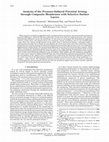
Langmuir, Feb 2, 2005
When a pressure gradient is applied through a charged selective membrane, the transmembrane elect... more When a pressure gradient is applied through a charged selective membrane, the transmembrane electrical potential difference, called the filtration potential, results from both the applied pressure and induced concentration difference across the membrane. In this work we investigate the electrokinetic properties relative to both active and support layers of a composite ceramic membrane close to the nanofiltration range. First, the volume charge density of the active layer is obtained by fitting a transport model to experimental rejection rates (which are controlled by the active layer only). Next, the value of the volume charge density is used to compute the theoretical filtration potential through the active layer. For sufficiently high permeate volume fluxes, the concentration difference across the active layer becomes constant, which allows assessing the membrane potential of the active layer. Experimental measurements of the overall filtration potential arising through the whole membrane are performed. The contribution of the support layer to this overall filtration potential is put in evidence. That implies that the membrane potential of the active layer cannot be deduced directly from the overall filtration potential measurements. Finally, the contribution of the support layer is singled out by subtracting the theoretical filtration potential of the active layer from the experimental filtration potential measured across the whole membrane (i.e., support + active layers). The amphoteric behavior of both layers is put in evidence, which is confirmed by electrophoretic measurements carried out with the powdered support layer and by recently reported tangential streaming potential measurements.
Desalination, Nov 1, 2006
Desalination, 1999
A simple and accurate determination of the point of zero charge of a ceramic membrane is reported... more A simple and accurate determination of the point of zero charge of a ceramic membrane is reported. It is based on pH variation measurements on adding an amphoteric oxide in a solution of a given pH. Up to now this method was effective for studying powder dispersions. In this work it is extended to ceramic membranes. In fact, we present

L'etude des proprietes electriques et electrocinetiques d'une membrane constitue une etap... more L'etude des proprietes electriques et electrocinetiques d'une membrane constitue une etape essentielle pour la comprehension et la maitrise de sa selectivite. En effet, les performances de filtration d'une membrane ne sont en general pas regies par les seules caracteristiques geometriques du materiau membranaire mais sont egalement affectees par les interactions electrostatiques entre les especes en solution et la surface de la membrane. Cette these traite de la caracterisation des proprietes electriques et electrocinetiques de membranes ceramiques de micro- et d'ultrafiltration. Dans cet objectif, quatre methodes experimentales (potentiel d'ecoulement, electro-osmose, potentiel de membrane et mesure de la resistance electrique de membrane par la technique d'impedance electrochimique) sont mises en uvre. Afin de relier les diverses grandeurs accessibles experimentalement au potentiel zeta ou au potentiel au plan d'helmholtz externe, grandeurs caracteristiques de l'interface membrane-solution, un modele de charge d'espace incluant une resolution numerique de l'equation non-lineaire de poisson-boltzmann est developpe. Celui-ci decrit le transport d'un electrolyte symetrique (en considerant les diffusivites individuelles des cations et des anions), a l'interieur d'un pore cylindrique homogene. Outre la determination du potentiel zeta ou du potentiel au plan d'helmholtz externe, ce modele permet l'analyse, et donc une meilleure comprehension, des phenomenes electriques et electrocinetiques se produisant a l'interieur des pores d'une membrane. La fiabilite du modele est verifiee en terme de conductivite electrolytique a l'interieur des pores d'une membrane ceramique d'ultrafiltration en confrontant les valeurs theoriques aux valeurs experimentales deduites de mesures de resistance electrique de membrane.
HAL (Le Centre pour la Communication Scientifique Directe), Nov 29, 2011
International audienc
HAL (Le Centre pour la Communication Scientifique Directe), 2012

HAL (Le Centre pour la Communication Scientifique Directe), 2010
The membrane potential technique was applied to a nanofiltration polyamide membrane to determine ... more The membrane potential technique was applied to a nanofiltration polyamide membrane to determine its mean pore radius and the dielectric constant of electrolyte solutions inside pores. To our knowledge, this is the first attempt to assess these features from membrane potential measurements. Membrane potential data were analyzed by means of the SEDE (steric electric and dielectric exclusion) transport model. Experiments were conducted with single-salt solutions of NaCl and CaCl 2 and mixed-salt solutions of NaCl and CaCl 2 at various concentrations. It was shown that the pore-size values deduced from the high-concentration limit of the membrane potential measured with the two single-salt solutions are in good agreement. With this parameter being known, the membrane potential measured at high salt concentration with electrolyte mixtures was further used to compute the dielectric constant inside pores. The latter was found to be smaller than its bulk value and to decrease when sodium ions were replaced by calcium ions.

TechConnect Briefs, Jun 21, 2010
Ion rejection by nanofiltration (NF) membranes with bipolar fixed charge distributions have been ... more Ion rejection by nanofiltration (NF) membranes with bipolar fixed charge distributions have been investigated theoretically. Salt flux rectification has been predicted as a result of the broken symmetry of the fixed charge distribution on the pore walls. The existence of an optimal volume flux (i.e. leading to the highest salt rejection) has been put in evidence when there is a region within the membrane pores that is more repulsive than the pore entrance with respect to a given electrolyte. For low Peclet numbers, our results show that bipolar membranes can lead to close rejections for both 2-1 and 1-2 asymmetric electrolytes. These performances result from specific properties of bipolar membranes and cannot be achieved with homogeneously charged membranes. The present work benefits the design of nanoporous membranes with targeted distribution of ionizable surface groups for advanced separations.

This article discusses macroscopic modeling of the transport mechanisms of ions through nanofiltr... more This article discusses macroscopic modeling of the transport mechanisms of ions through nanofiltration membranes. The modeling is based on mechanistic approaches that consider nanofiltration membranes as bundles of (nano)pores and ionic transport as resulting from hindered diffusion, electromigration, and convection. The governing equations are presented and the main assumptions and approximations are reviewed and discussed. Special attention is given to the uniform potential approximation (also called homogeneous approximation), which forms the basis of most current transport models used in nanofiltration. The impact of steric hindrance, membrane fixed charge density, and salt concentration on the rejection of single-salt solutions and electrolyte mixtures is illustrated through a series of examples. Some recent advances in nanofiltration modeling (introduction into transport models of the dielectric exclusion phenomena and spatial inhomogeneities of the fixed charge) are also briefly discussed. Keywords: nanofiltration; transport phenomena; modeling; charged membranes; transport theory
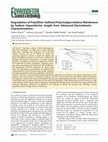
Environmental Science & Technology, Nov 10, 2014
Poly(ether sulfone) (PES)/polyvinylpyrrolidone (PVP) membranes are widely used in various industr... more Poly(ether sulfone) (PES)/polyvinylpyrrolidone (PVP) membranes are widely used in various industrial fields such as drinking water production and in the dairy industry. However, the use of oxidants to sanitize the processing equipment is known to impair the integrity and lifespan of polymer membranes. In this work we showed how thorough electrokinetic measurements can provide essential information regarding the mechanism of degradation of PES/ PVP membranes by sodium hypochlorite. Tangential streaming current measurements were performed with ultrafiltration and nanofiltration PES/PVP membranes for various aging times. The electrokinetic characterization of membranes was complemented by FTIR-ATR spectroscopy. Results confirmed that sodium hypochlorite induces the degradation of both PES and PVP. This latter is easily oxidized by sodium hypochlorite, which leads to an increase in the negative charge density of the membrane due to the formation of carboxylic acid groups. The PVP was also found to be partly released from the membrane with aging time. Thanks to the advanced electrokinetic characterization implemented in this work it was possible for the first time to demonstrate that two different mechanisms are involved in the degradation of PES. Phenol groups were first formed as a result of the oxidation of PES aromatic rings by substitution of hydrogen by hydroxyl radicals. For more severe aging conditions, this membrane degradation mechanism was followed by the formation of sulfonic acid functions, thus indicating a second degradation process through scission of PES chains.
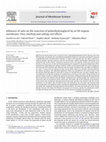
Journal of Membrane Science, Feb 1, 2010
Rejection rate measurements were carried out with a single polyethyleneglycol (PEG) solution and ... more Rejection rate measurements were carried out with a single polyethyleneglycol (PEG) solution and mixed PEG/inorganic salt solutions for a nanofiltration polyamide membrane. It was observed that PEG rejection is significantly lower in mixed-solute solutions, i.e. when a salt is present (KCl, LiCl, MgCl 2 and K 2 SO 4), and that rejection rate drop increases with salt concentration. Similar nanofiltration experiments were conducted with an NF ceramic membrane in previous works. The rejection of PEGs was also found to decrease in the presence of salts and this phenomenon was imputed to the partial dehydration of PEG molecules by surrounding ions (salting-out effect). Unlike results obtained with the ceramic membrane, the lowering of PEG rejection rates observed with the organic membrane does not follow the Hofmeister series. It means that the salting-out effect cannot solely explain the rejection lowering found for the organic membrane. The additional hypothesis which was considered in the present work is that the rejection lowering might be caused by an increase in the effective pore size (pore swelling) due to accumulation of counterions inside pores resulting from an increase in the surface charge density in the presence of ions. In order to evaluate the significance of the pore swelling phenomenon, the experimental data of rejection rates obtained with the organic membrane were used to compute the variation in the mean pore radius in the presence of the various salts (the Stokes radii of PEG molecules in the presence of the various salts having been determined previously from rejection rates obtained with the ceramic membrane). It was shown that the effective pore size depends on the salt nature and increases with salt concentration. The hypothesis of pore swelling was supported by electrokinetics charge density data calculated from tangential streaming potential measurements: the more the membrane surface charge density increases, the higher the effective average pore size becomes. Finally, the contribution of pore swelling and salting-out to the overall decrease in the rejection rate of PEG was evaluated.
Journal of Membrane Science, Apr 1, 2005
... Anthony Szymczyk Corresponding Author Contact Information , E-mail The Corresponding Author a... more ... Anthony Szymczyk Corresponding Author Contact Information , E-mail The Corresponding Author and Patrick Fievet. ... the distribution of ions at the pore inlet and outlet [2], [3], [4], [5], [6], [7] and [8]. Among these continuous models, the so-called DSPM (Donnan-Steric partitioning ...








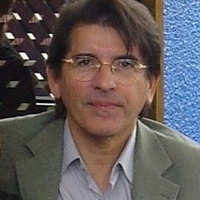
Uploads
Papers by Anthony Szymczyk